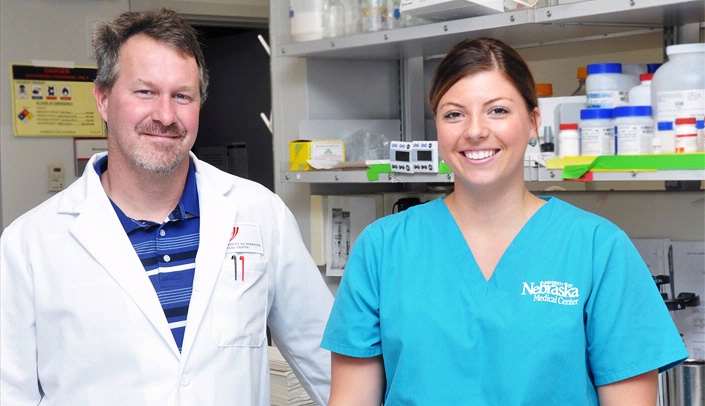James Wahl, Ph.D., is interested in how cells move.
Specifically, he is interested in epithelial cell adhesion – epithelial tissues include the skin as well as the inside of the mouth. “We’d like to know how these cells migrate in order to close cuts on the skin or in our mouths.”
In exploring how cells move, Dr. Wahl, an associate professor of oral biology and cell biologist at the UNMC College of Dentistry, may discover a way to limit metastasis of tumors of the mouth and tongue, as well as other tumors that originate in other epithelial tissues.
His project is funded by a three-year, $280,000 National Institutes of Health R15 grant.
“We’re interested in how the cells stick together, how they adhere to one another,” Dr. Wahl said. “When tumor cells arise, they come apart from one another and gain the ability to metastasize. When epithelial cells are in a normal tissue, they stay put – so you maintain that epithelial lining.”
When cells are forced to migrate – when the skin is cut, for example – the cellular adhesive junctions are remodeled.
“We’re interested in how their adhesive strength changes during processes like wound healing, or how they’re altered during tumor cell metastasis.”
Early stage tumors that form an adherent mass are often easy to treat by surgical removal, Dr. Wahl said.
“The problem is when the tumor grows to the point where the cancer cells begin to migrate away from the primary tumor and start relocating to the rest of the body,” he said. “Then you get metastasis, which if we can limit, then hopefully we can slow things down and give chemotherapies more time to work.”
Dr. Wahl works with third-year dental student Elizabeth Sand and may draw more research help from University of Nebraska-Lincoln students (R15 grants are designed to bring students into the research process).
Healthy epithelial cells are tightly associated with one another, Dr. Wahl said. “Under a microscope, these junctions made of protein complexes or cell sheets, that hold the cells together and look static.
“But while we know a lot about the static snapshot of what these complexes look like, we don’t know how these adhesive junctions are remodeled – when cells have to detach from their neighbor and clamber into a wound, for example.
“We’re trying to figure out what are the control mechanisms that cause one cell to say, ‘Hey, I have to move over there.’ And then when it gets over there, how does it reestablish that junction to reform that cell sheet.
“So we’re looking closely at the signaling pathways that control adhesiveness.”
